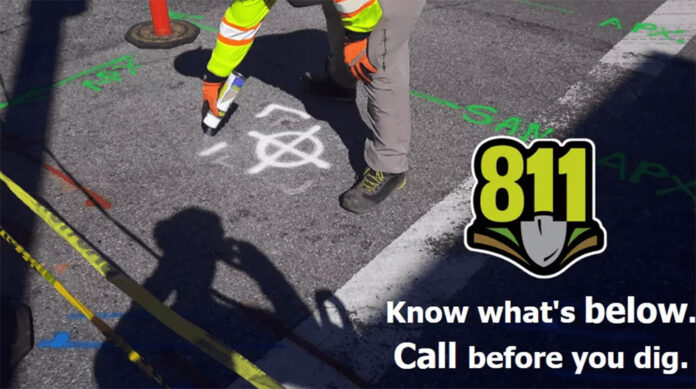Damaging an underground utility line during excavation can result into thousands of dollars in repair costs
Corporate News
April 9, 2024 – San Francisco California. — With the warmer weather months approaching, homeowners may want to turn their attention to projects around the house that involve digging. Whether it’s repairing a fence or removing a fallen tree due to winter storm damage, or any other project that involves excavation, calling 811 before starting the project will help customers avoid damaging underground utility lines. and will avoid costly repair costs. April is recognized as National Safe Digging Month to raise awareness about the importance of calling 811 before any digging project, large or small.
Underground utility lines may be shallow, often just inches below the surface due to erosion, previous excavation or landscaping projects, shifting or settling of ground, and uneven surfaces. Customers should call 811 a minimum of two business days before beginning any excavation project, large or small, as damaging an underground utility line while digging is dangerous and can subject customers to liability for repair costs. which average $3,500.
“Making a free call to 811 two business days before starting your excavation project will help keep you, your family, and your neighbors safe and avoid inconvenient outages. Hitting an underground utility line during excavation can be dangerous and require expensive repairs; so remember to call 811, a toll-free call for all excavation projects, both large and small,” says Joe Forline, senior vice president of gas operations for PG&E.
In the warmer summer months there will be an increase in the number of excavation projects and, unfortunately, many of these projects are carried out without making a free call to 811 to flag utilities at the project sites. In fact, according to a recent national survey conducted by the Common Ground Alliance (CGA), 56% of homeowners plan to dig without first calling 811. However, not calling 811 before digging led to more than 1,300 incidents during 2023 in which underground utility lines were damaged due to excavation in the PG&E service area alone.
2023 in figures:
- There were 1,335 incidents in Northern and Central California in which homeowners or contractors damaged underground gas or electric lines while digging.
- In 63 percent of incidents in which an underground utility line was damaged due to excavation, there was no 811 call.
- Specifically for homeowners, this percentage increases to 90 percent.
- The average cost to repair a damaged utility line is $3,500.
- The main causes of damage to underground utility lines when excavating are: building or repairing a fence, gardening and landscaping, planting a tree or removing a stump, drainage and irrigation work, and construction of a patio or terrace.
Calling 811 is fast and free:
- Customers should call 811 at least two business days before beginning any project involving excavation, regardless of its magnitude. Customers can also visit 811express.com to have utility lines marked for their project site.
- Professional workers from all utilities (gas, electric, water, sewer, and telecommunications) will be dispatched to mark the location of all underground utility lines at the project site, either by flagging, spray painting, or both.
- The 811 USA North call center, serving central and northern California, is staffed 24 hours a day, seven days a week, and offers translation services into Spanish and other languages.
PG&E Tips for Safe Digging
Mark the project area with white: Identify the excavation area by drawing a box around the area with white paint, white flags, white chalk, or even white flour.
Call 811 or submit a request online at least two business days before digging: Have the general project address and location, project start date, and type of excavation activity available. PG&E and other utilities will identify underground facilities in the area for free. Applications can be submitted no later than 14 days before the project begins.
Digging Safety: Use hand tools when digging within 24 inches of the outside edge of underground lines. Leave any flags, stakes or utility paint marks in place until the project is complete. Fill and compact the soil.
Watch for signs of a natural gas leak: Watch for a “rotten egg” smell, listen for hissing, hissing or roaring sounds, and look for dirt thrown into the air, bubbles in a pond or stream, or dead vegetation. or dying in a humid area.
About CGA
The CGA is a member-driven association of nearly 4,200 damage prevention professionals spanning all facets of the underground utility industry. Established in 2000, CGA is committed to saving lives and preventing damage to North America’s underground infrastructure by promoting effective damage prevention practices. The CGA has established itself as the leading source of damage prevention data and information in an effort to reduce damage to underground facilities in North America through shared responsibility among all stakeholders. For more information, visit CGA on the Web at http://www.commongroundalliance.com.



